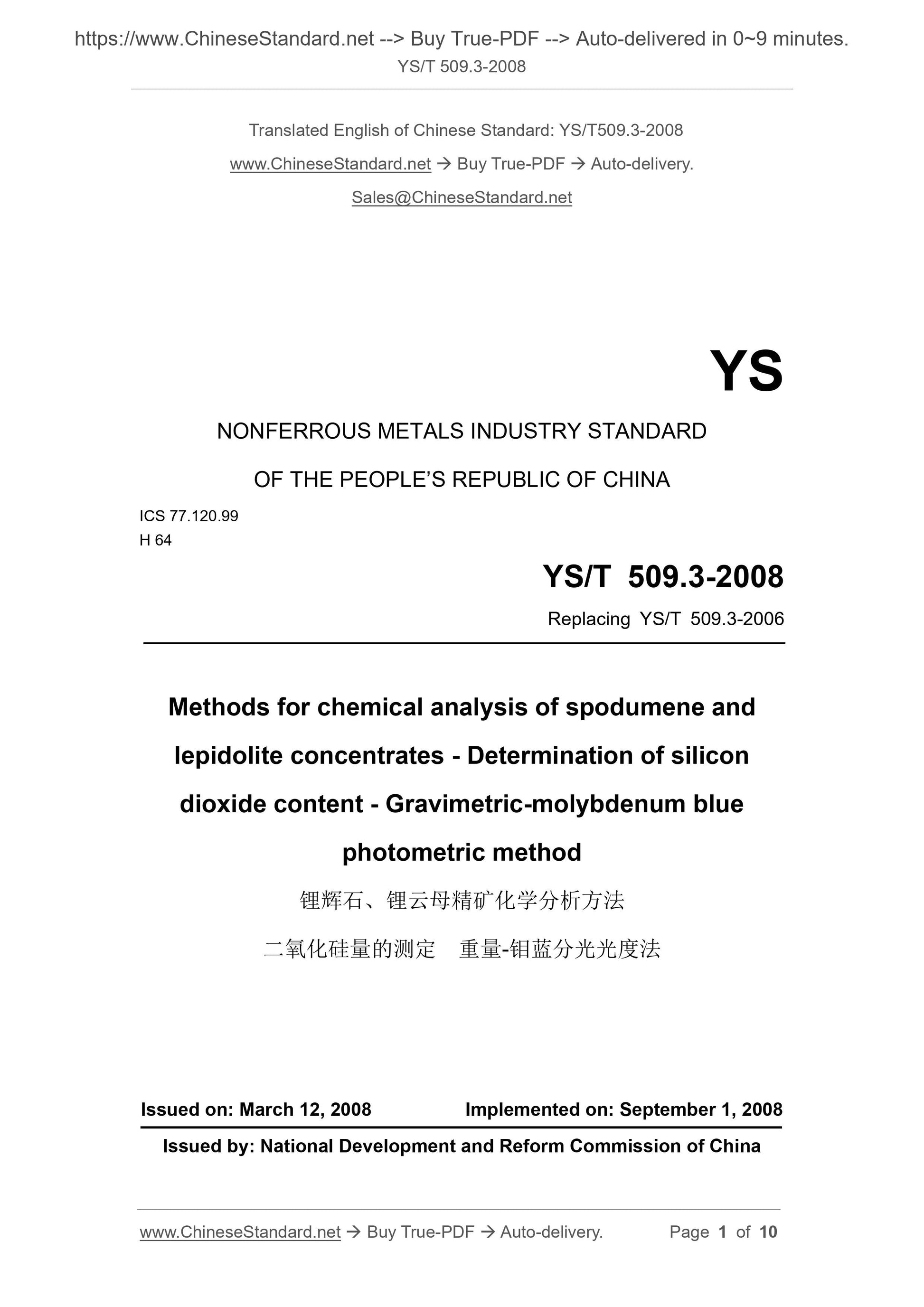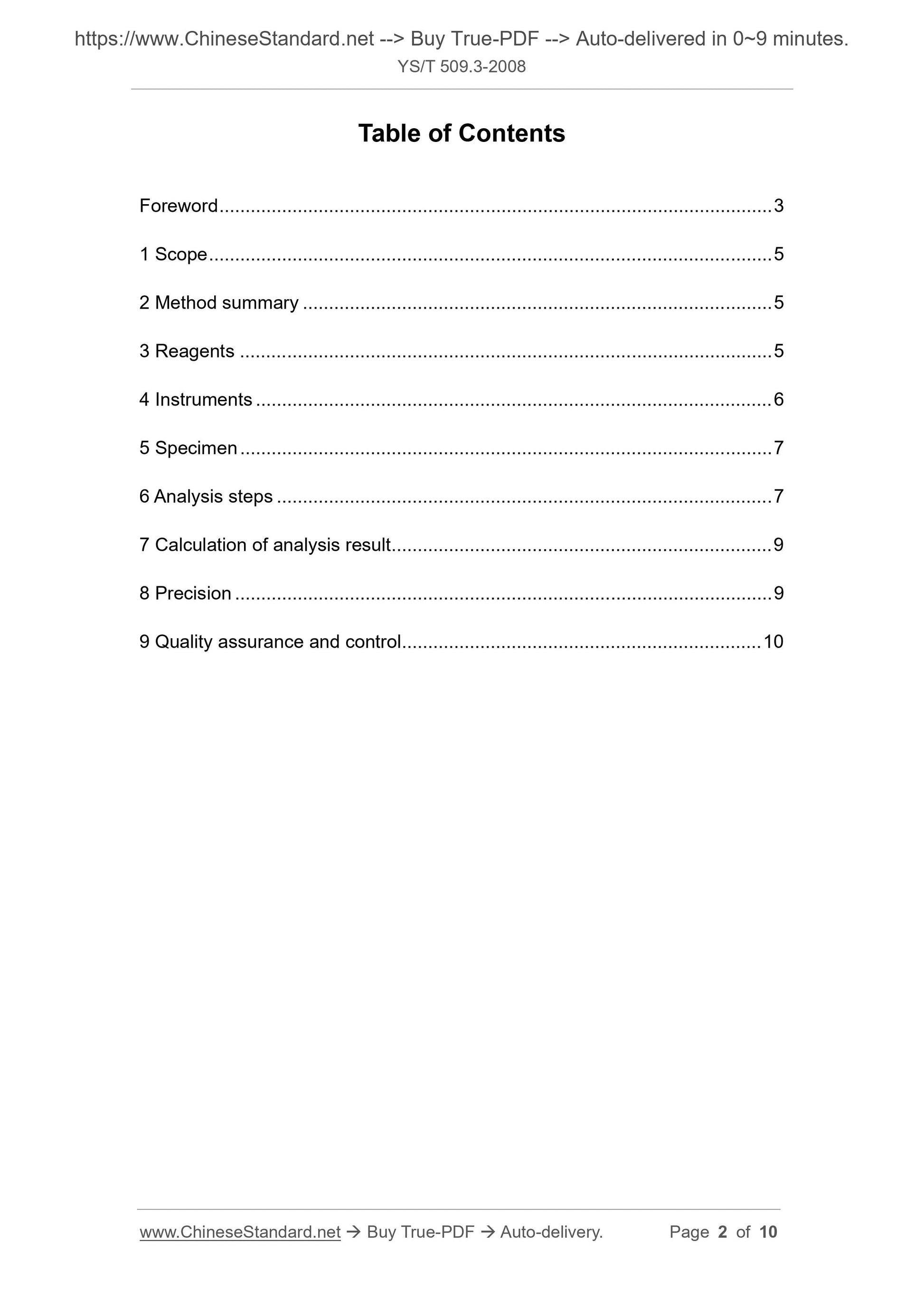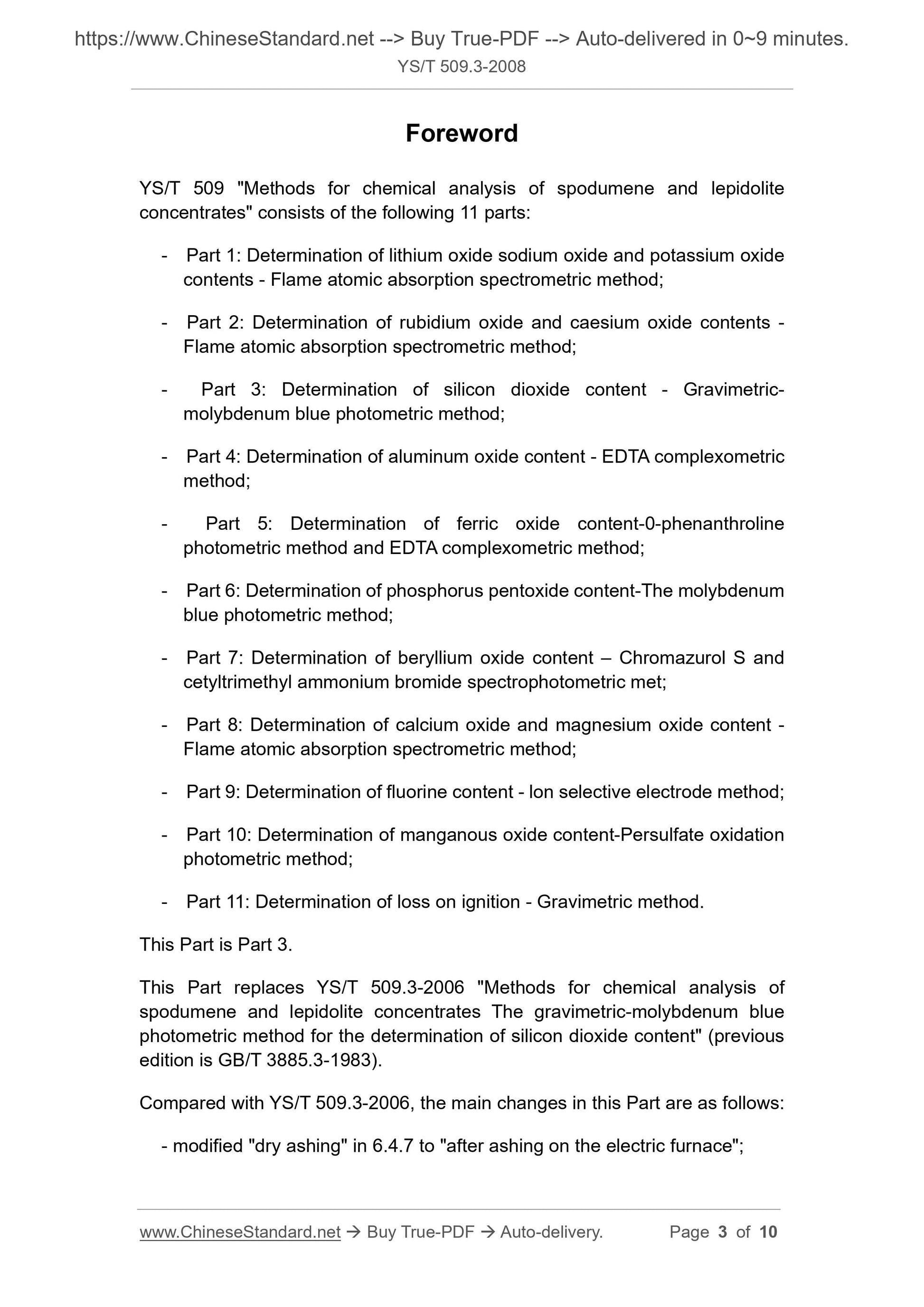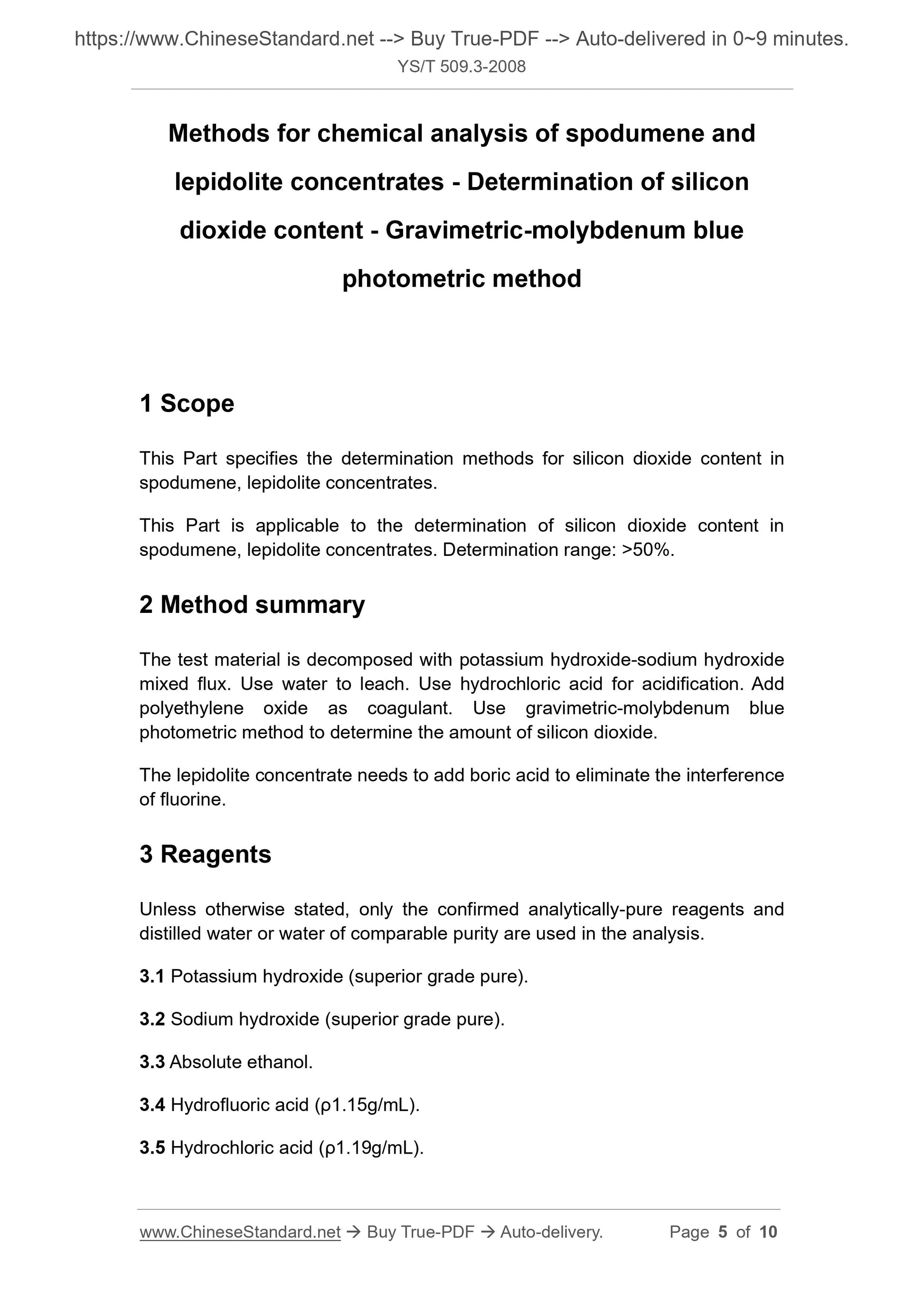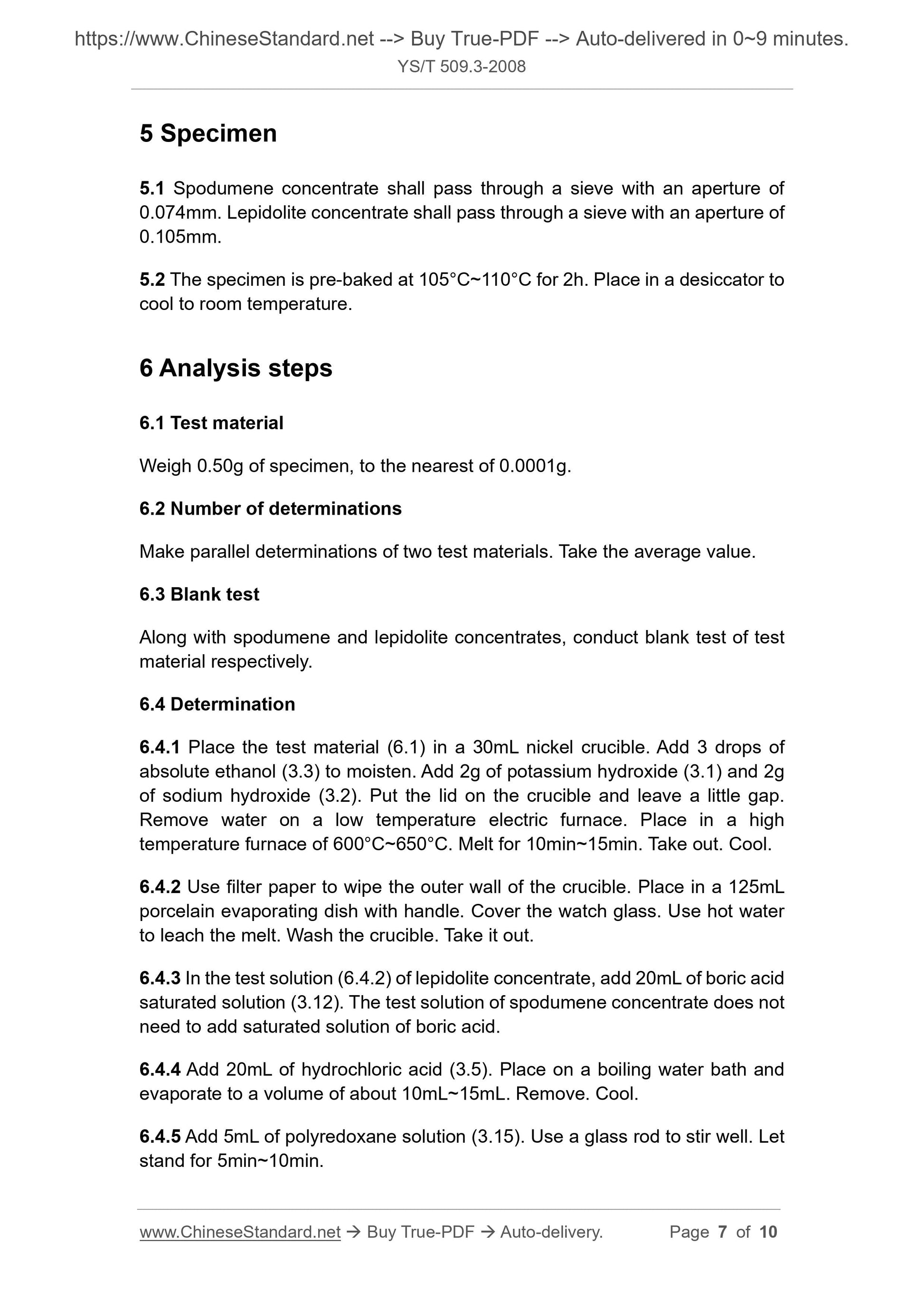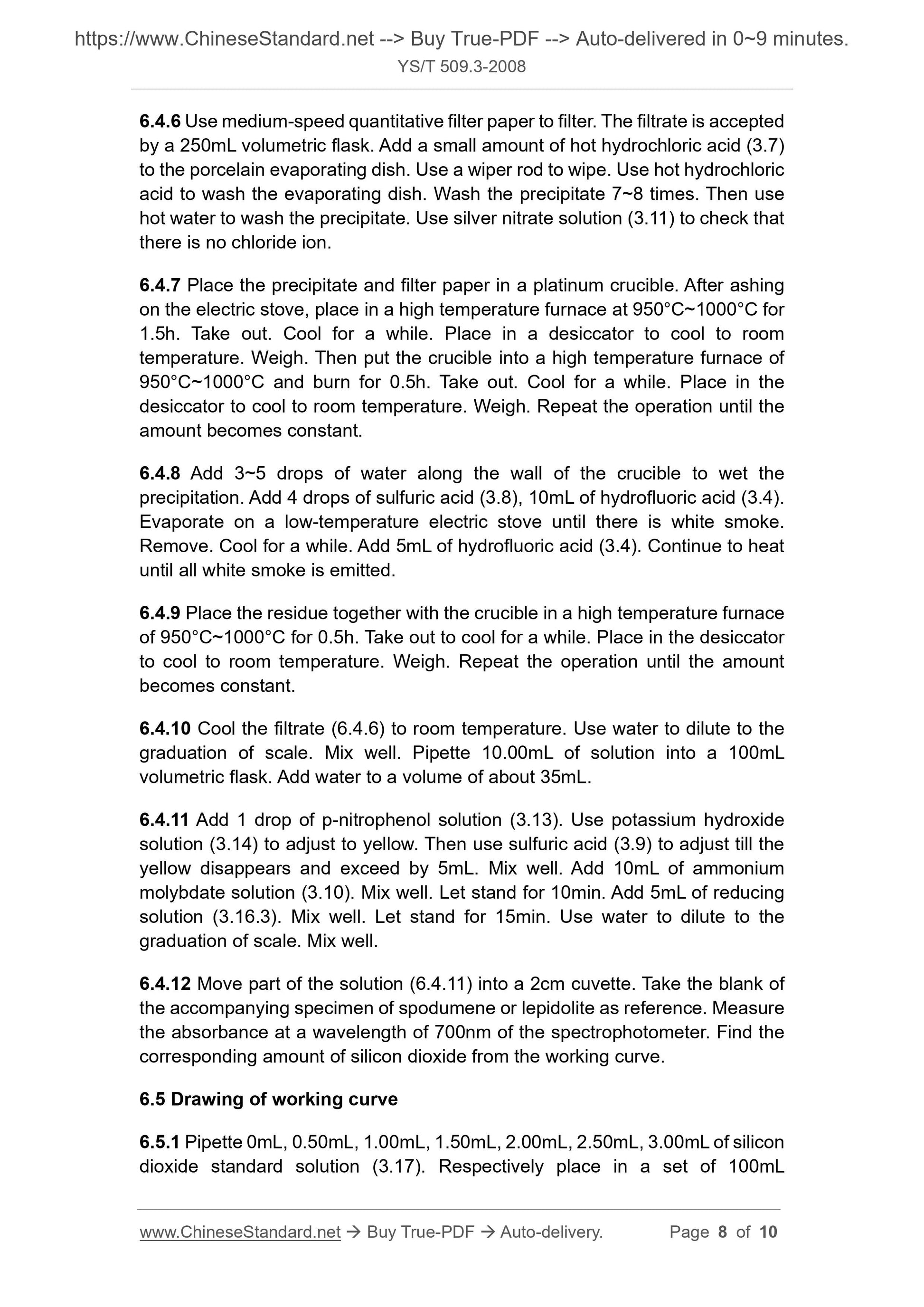PayPal, credit cards. Download editable-PDF & invoice in 1 second!
YS/T 509.3-2008 English PDF (YST509.3-2008)
YS/T 509.3-2008 English PDF (YST509.3-2008)
Precio habitual
$150.00 USD
Precio habitual
Precio de oferta
$150.00 USD
Precio unitario
/
por
Los gastos de envío se calculan en la pantalla de pago.
No se pudo cargar la disponibilidad de retiro
Delivery: 3 seconds. Download true-PDF + Invoice.
Get QUOTATION in 1-minute: Click YS/T 509.3-2008
Historical versions: YS/T 509.3-2008
Preview True-PDF (Reload/Scroll if blank)
YS/T 509.3-2008: Methods for chemical analysis of spodumene and lepidolite concentrates. Determination of silicon dioxide content. Gravimetric-molybdenum blue photometric method
YS/T 509.3-2008
YS
NONFERROUS METALS INDUSTRY STANDARD
OF THE PEOPLE’S REPUBLIC OF CHINA
ICS 77.120.99
H 64
Replacing YS/T 509.3-2006
Methods for chemical analysis of spodumene and
lepidolite concentrates - Determination of silicon
dioxide content - Gravimetric-molybdenum blue
photometric method
ISSUED ON: MARCH 12, 2008
IMPLEMENTED ON: SEPTEMBER 1, 2008
Issued by: National Development and Reform Commission of China
Table of Contents
Foreword ... 3
1 Scope ... 5
2 Method summary ... 5
3 Reagents ... 5
4 Instruments ... 6
5 Specimen ... 7
6 Analysis steps ... 7
7 Calculation of analysis result ... 9
8 Precision ... 9
9 Quality assurance and control ... 10
Foreword
YS/T 509 "Methods for chemical analysis of spodumene and lepidolite
concentrates" consists of the following 11 parts:
- Part 1: Determination of lithium oxide sodium oxide and potassium oxide
contents - Flame atomic absorption spectrometric method;
- Part 2: Determination of rubidium oxide and caesium oxide contents -
Flame atomic absorption spectrometric method;
- Part 3: Determination of silicon dioxide content - Gravimetric-
molybdenum blue photometric method;
- Part 4: Determination of aluminum oxide content - EDTA complexometric
method;
- Part 5: Determination of ferric oxide content-0-phenanthroline
photometric method and EDTA complexometric method;
- Part 6: Determination of phosphorus pentoxide content-The molybdenum
blue photometric method;
- Part 7: Determination of beryllium oxide content – Chromazurol S and
cetyltrimethyl ammonium bromide spectrophotometric met;
- Part 8: Determination of calcium oxide and magnesium oxide content -
Flame atomic absorption spectrometric method;
- Part 9: Determination of fluorine content - lon selective electrode method;
- Part 10: Determination of manganous oxide content-Persulfate oxidation
photometric method;
- Part 11: Determination of loss on ignition - Gravimetric method.
This Part is Part 3.
This Part replaces YS/T 509.3-2006 "Methods for chemical analysis of
spodumene and lepidolite concentrates The gravimetric-molybdenum blue
photometric method for the determination of silicon dioxide content" (previous
edition is GB/T 3885.3-1983).
Compared with YS/T 509.3-2006, the main changes in this Part are as follows:
- modified "dry ashing" in 6.4.7 to "after ashing on the electric furnace";
Methods for chemical analysis of spodumene and
lepidolite concentrates - Determination of silicon
dioxide content - Gravimetric-molybdenum blue
photometric method
1 Scope
This Part specifies the determination methods for silicon dioxide content in
spodumene, lepidolite concentrates.
This Part is applicable to the determination of silicon dioxide content in
spodumene, lepidolite concentrates. Determination range: >50%.
2 Method summary
The test material is decomposed with potassium hydroxide-sodium hydroxide
mixed flux. Use water to leach. Use hydrochloric acid for acidification. Add
polyethylene oxide as coagulant. Use gravimetric-molybdenum blue
photometric method to determine the amount of silicon dioxide.
The lepidolite concentrate needs to add boric acid to eliminate the interference
of fluorine.
3 Reagents
Unless otherwise stated, only the confirmed analytically-pure reagents and
distilled water or water of comparable purity are used in the analysis.
3.1 Potassium hydroxide (superior grade pure).
3.2 Sodium hydroxide (superior grade pure).
3.3 Absolute ethanol.
3.4 Hydrofluoric acid (ρ1.15g/mL).
3.5 Hydrochloric acid (ρ1.19g/mL).
5 Specimen
5.1 Spodumene concentrate shall pass through a sieve with an aperture of
0.074mm. Lepidolite concentrate shall pass through a sieve with an aperture of
0.105mm.
5.2 The specimen is pre-baked at 105°C~110°C for 2h. Place in a desiccator to
cool to room temperature.
6 Analysis steps
6.1 Test material
Weigh 0.50g of specimen, to the nearest of 0.0001g.
6.2 Number of determinations
Make parallel determinations of two test materials. Take the average value.
6.3 Blank test
Along with spodumene and lepidolite concentrates, conduct blank test of test
material respectively.
6.4 Determination
6.4.1 Place the test material (6.1) in a 30mL nickel crucible. Add 3 drops of
absolute ethanol (3.3) to moisten. Add 2g of potassium hydroxide (3.1) and 2g
of sodium hydroxide (3.2). Put the lid on the crucible and leave a little gap.
Remove water on a low temperature electric furnace. Place in a high
temperature furnace of 600°C~650°C. Melt for 10min~15min. Take out. Cool.
6.4.2 Use filter paper to wipe the outer wall of the crucible. Place in a 125mL
porcelain evaporating dish with handle. Cover the watch glass. Use hot water
to leach the melt. Wash the crucible. Take it out.
6.4.3 In the test solution (6.4.2) of lepidolite concentrate, add 20mL of boric acid
saturated solution (3.12). The test solution of spodumene concentrate does not
need to add saturated solution of boric acid.
6.4.4 Add 20mL of hydrochloric acid (3.5). Place on a boiling water bath and
evaporate to a volume of about 10mL~15mL. Remove. Cool.
6.4.5 Add 5mL of polyredoxane solution (3.15). Use a glass rod to stir well. Let
stand for 5min~10min.
6.4.6 Use medium-speed quantitative filter paper to filter. The filtrate is accepted
by a 250mL volumetric flask. Add a small amount of hot hydrochloric acid (3.7)
to the porcelain evaporating dish. Use a wiper rod to wipe. Use hot hydrochloric
acid to wash the evaporating dish. Wash the precipitate 7~8 times. Then use
hot water to wash the precipitate. Use silver nitrate solution (3.11) to check that
there is no chloride ion.
6.4.7 Place the precipitate and filter paper in a platinum crucible. After ashing
on the electric stove, place in a high temperature furnace at 950°C~1000°C for
1.5h. Take out. Cool for a while. Place in a desiccator to cool to room
temperature. Weigh. Then put the crucible into a high temperature furnace of
950°C~1000°C and burn for 0.5h. Take out. Cool for a while. Place in the
desiccator to cool to room temperature. Weigh. Repeat the operation until the
amount becomes constant.
6.4.8 Add 3~5 drops of water along the wall of the crucible to wet the
precipitation. Add 4 drops of sulfuric acid (3.8), 10mL of hydrofluoric acid (3.4).
Evaporate on a low-temperature electric stove until there is white smoke.
Remove. Cool for a while. Add 5mL of hydrofluoric acid (3.4). Continue to heat
until all white smoke is emitted.
6.4.9 Place the residue together with the crucible in a high temperature furnace
of 950°C~1000°C for 0.5h. Take out to cool for a while. Place in the desiccator
to cool to room temperature. Weigh. Repeat the operation until the amount
becomes constant.
6.4.10 Cool the filtrate (6.4.6) to room temperature. Use water to dilute to the
graduation of scale. Mix well. Pipette 10.00mL of solution into a 100mL
volumetric flask. Add water to a volume of about 35mL.
6.4.11 Add 1 drop of p-nitrophenol solution (3.13). Use potassium hydroxide
solution (3.14) to adjust to yellow. Then use sulfuric acid (3.9) to adjust till the
yellow disappears and exceed by 5mL. Mix well. Add 10mL of ammonium
molybdate solution (3.10). Mix well. Let stand for 10min. Add 5mL of reducing
solution (3.16.3). Mix well. Let stand for 15min. Use water to dilute to the
graduation of scale. Mix well.
6.4.12 Move part of the solution (...
Get QUOTATION in 1-minute: Click YS/T 509.3-2008
Historical versions: YS/T 509.3-2008
Preview True-PDF (Reload/Scroll if blank)
YS/T 509.3-2008: Methods for chemical analysis of spodumene and lepidolite concentrates. Determination of silicon dioxide content. Gravimetric-molybdenum blue photometric method
YS/T 509.3-2008
YS
NONFERROUS METALS INDUSTRY STANDARD
OF THE PEOPLE’S REPUBLIC OF CHINA
ICS 77.120.99
H 64
Replacing YS/T 509.3-2006
Methods for chemical analysis of spodumene and
lepidolite concentrates - Determination of silicon
dioxide content - Gravimetric-molybdenum blue
photometric method
ISSUED ON: MARCH 12, 2008
IMPLEMENTED ON: SEPTEMBER 1, 2008
Issued by: National Development and Reform Commission of China
Table of Contents
Foreword ... 3
1 Scope ... 5
2 Method summary ... 5
3 Reagents ... 5
4 Instruments ... 6
5 Specimen ... 7
6 Analysis steps ... 7
7 Calculation of analysis result ... 9
8 Precision ... 9
9 Quality assurance and control ... 10
Foreword
YS/T 509 "Methods for chemical analysis of spodumene and lepidolite
concentrates" consists of the following 11 parts:
- Part 1: Determination of lithium oxide sodium oxide and potassium oxide
contents - Flame atomic absorption spectrometric method;
- Part 2: Determination of rubidium oxide and caesium oxide contents -
Flame atomic absorption spectrometric method;
- Part 3: Determination of silicon dioxide content - Gravimetric-
molybdenum blue photometric method;
- Part 4: Determination of aluminum oxide content - EDTA complexometric
method;
- Part 5: Determination of ferric oxide content-0-phenanthroline
photometric method and EDTA complexometric method;
- Part 6: Determination of phosphorus pentoxide content-The molybdenum
blue photometric method;
- Part 7: Determination of beryllium oxide content – Chromazurol S and
cetyltrimethyl ammonium bromide spectrophotometric met;
- Part 8: Determination of calcium oxide and magnesium oxide content -
Flame atomic absorption spectrometric method;
- Part 9: Determination of fluorine content - lon selective electrode method;
- Part 10: Determination of manganous oxide content-Persulfate oxidation
photometric method;
- Part 11: Determination of loss on ignition - Gravimetric method.
This Part is Part 3.
This Part replaces YS/T 509.3-2006 "Methods for chemical analysis of
spodumene and lepidolite concentrates The gravimetric-molybdenum blue
photometric method for the determination of silicon dioxide content" (previous
edition is GB/T 3885.3-1983).
Compared with YS/T 509.3-2006, the main changes in this Part are as follows:
- modified "dry ashing" in 6.4.7 to "after ashing on the electric furnace";
Methods for chemical analysis of spodumene and
lepidolite concentrates - Determination of silicon
dioxide content - Gravimetric-molybdenum blue
photometric method
1 Scope
This Part specifies the determination methods for silicon dioxide content in
spodumene, lepidolite concentrates.
This Part is applicable to the determination of silicon dioxide content in
spodumene, lepidolite concentrates. Determination range: >50%.
2 Method summary
The test material is decomposed with potassium hydroxide-sodium hydroxide
mixed flux. Use water to leach. Use hydrochloric acid for acidification. Add
polyethylene oxide as coagulant. Use gravimetric-molybdenum blue
photometric method to determine the amount of silicon dioxide.
The lepidolite concentrate needs to add boric acid to eliminate the interference
of fluorine.
3 Reagents
Unless otherwise stated, only the confirmed analytically-pure reagents and
distilled water or water of comparable purity are used in the analysis.
3.1 Potassium hydroxide (superior grade pure).
3.2 Sodium hydroxide (superior grade pure).
3.3 Absolute ethanol.
3.4 Hydrofluoric acid (ρ1.15g/mL).
3.5 Hydrochloric acid (ρ1.19g/mL).
5 Specimen
5.1 Spodumene concentrate shall pass through a sieve with an aperture of
0.074mm. Lepidolite concentrate shall pass through a sieve with an aperture of
0.105mm.
5.2 The specimen is pre-baked at 105°C~110°C for 2h. Place in a desiccator to
cool to room temperature.
6 Analysis steps
6.1 Test material
Weigh 0.50g of specimen, to the nearest of 0.0001g.
6.2 Number of determinations
Make parallel determinations of two test materials. Take the average value.
6.3 Blank test
Along with spodumene and lepidolite concentrates, conduct blank test of test
material respectively.
6.4 Determination
6.4.1 Place the test material (6.1) in a 30mL nickel crucible. Add 3 drops of
absolute ethanol (3.3) to moisten. Add 2g of potassium hydroxide (3.1) and 2g
of sodium hydroxide (3.2). Put the lid on the crucible and leave a little gap.
Remove water on a low temperature electric furnace. Place in a high
temperature furnace of 600°C~650°C. Melt for 10min~15min. Take out. Cool.
6.4.2 Use filter paper to wipe the outer wall of the crucible. Place in a 125mL
porcelain evaporating dish with handle. Cover the watch glass. Use hot water
to leach the melt. Wash the crucible. Take it out.
6.4.3 In the test solution (6.4.2) of lepidolite concentrate, add 20mL of boric acid
saturated solution (3.12). The test solution of spodumene concentrate does not
need to add saturated solution of boric acid.
6.4.4 Add 20mL of hydrochloric acid (3.5). Place on a boiling water bath and
evaporate to a volume of about 10mL~15mL. Remove. Cool.
6.4.5 Add 5mL of polyredoxane solution (3.15). Use a glass rod to stir well. Let
stand for 5min~10min.
6.4.6 Use medium-speed quantitative filter paper to filter. The filtrate is accepted
by a 250mL volumetric flask. Add a small amount of hot hydrochloric acid (3.7)
to the porcelain evaporating dish. Use a wiper rod to wipe. Use hot hydrochloric
acid to wash the evaporating dish. Wash the precipitate 7~8 times. Then use
hot water to wash the precipitate. Use silver nitrate solution (3.11) to check that
there is no chloride ion.
6.4.7 Place the precipitate and filter paper in a platinum crucible. After ashing
on the electric stove, place in a high temperature furnace at 950°C~1000°C for
1.5h. Take out. Cool for a while. Place in a desiccator to cool to room
temperature. Weigh. Then put the crucible into a high temperature furnace of
950°C~1000°C and burn for 0.5h. Take out. Cool for a while. Place in the
desiccator to cool to room temperature. Weigh. Repeat the operation until the
amount becomes constant.
6.4.8 Add 3~5 drops of water along the wall of the crucible to wet the
precipitation. Add 4 drops of sulfuric acid (3.8), 10mL of hydrofluoric acid (3.4).
Evaporate on a low-temperature electric stove until there is white smoke.
Remove. Cool for a while. Add 5mL of hydrofluoric acid (3.4). Continue to heat
until all white smoke is emitted.
6.4.9 Place the residue together with the crucible in a high temperature furnace
of 950°C~1000°C for 0.5h. Take out to cool for a while. Place in the desiccator
to cool to room temperature. Weigh. Repeat the operation until the amount
becomes constant.
6.4.10 Cool the filtrate (6.4.6) to room temperature. Use water to dilute to the
graduation of scale. Mix well. Pipette 10.00mL of solution into a 100mL
volumetric flask. Add water to a volume of about 35mL.
6.4.11 Add 1 drop of p-nitrophenol solution (3.13). Use potassium hydroxide
solution (3.14) to adjust to yellow. Then use sulfuric acid (3.9) to adjust till the
yellow disappears and exceed by 5mL. Mix well. Add 10mL of ammonium
molybdate solution (3.10). Mix well. Let stand for 10min. Add 5mL of reducing
solution (3.16.3). Mix well. Let stand for 15min. Use water to dilute to the
graduation of scale. Mix well.
6.4.12 Move part of the solution (...
Share







